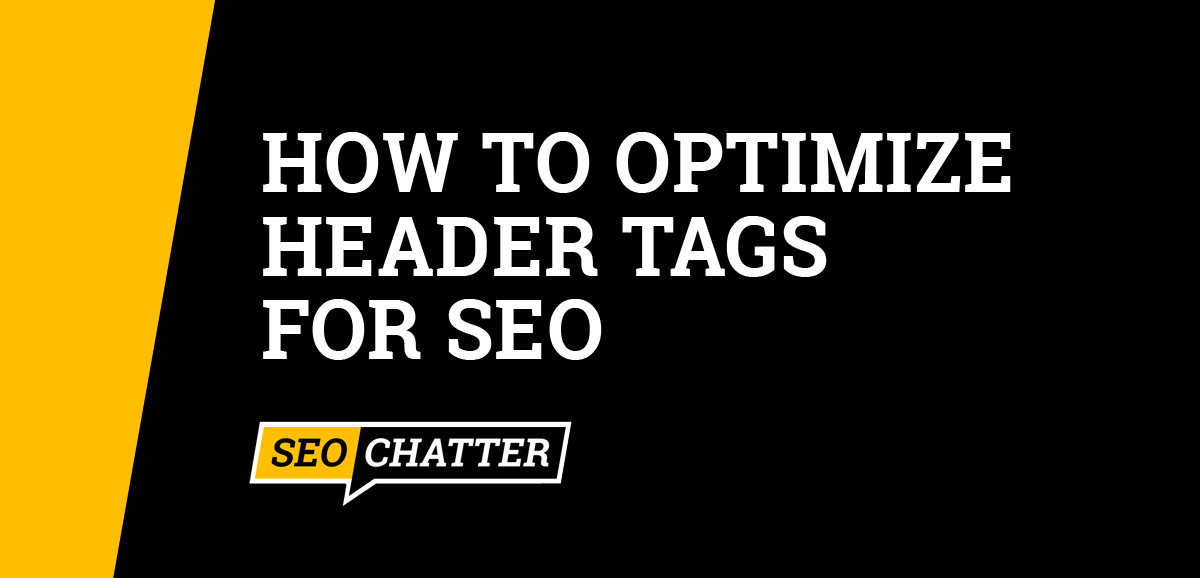This search engine optimization (SEO) guide explains how to optimize header tags for SEO.
Below, you’ll find a list of the top header tag optimization tips you can use to improve the rankings and traffic for your website based on HTML heading tag best practices in digital marketing.
There’s also a section with additional resources that explain more about the fundamentals of header tags in HTML to help you create a better search engine optimization strategy.

How to Optimize Header Tags for SEO
1. Use Proper Header Tag Structure
The first way to optimize header tags for SEO is by using proper structure in your header tags. Proper HTML structure improves crawlability, indexing, and rankings.
Use the H1 tag for the page title that sums up the general topic of the content. Use H2 tags to define the subtopics to split your content into chapters. H3 tags should be located under the associated H2 tag to diver deeper into the subsections of the information. H4s go under H3s for even more detailed explanations, and H5s go under H6s.
Avoid using header tags as a way to format text, such as bolding it or making the font size bigger. Using HTML headings outside their intended function will confuse both readers and search engine crawlers.
2. Always Use An H1 Tag
Another best practice for header tag optimization is through good use of the H1 tag. This is the most important header for readers and search engines like Google, Yahoo, and Bing.
You should always use an H1 heading on the page because it carries the most weight for SEO. Also, there should only be one H1 tag in the document structure. Having more than one H1 heading can confuse search engine crawlers as to what the main topic is for SEO. Additionally, the H1 heading should contain your primary keyword because it carries the most weight for SEO.
Keep in mind: a <title> tag is not the same as an <H1> tag. The title tag contains the metadata information for the page title that appears in the search engine results pages (SERPs) for the website listing. The H1 tag is seen on the page by the user reading the content.
3. Put Your Primary Keyword In The First Subheader Tag
Your H1 acts as the main heading for search engine crawlers, while H2 tags are used to define the subtopics for the page. A good strategy for on-page SEO is to place your primary keyword in the first H2 subheader on the page. This confirms the topical relevance of the keyword to help improve search engine rankings.
4. Include An H2 Tag For Every Keyword
Including an H2 tag for every target keyword on your page is a good way to optimize header tags for search engines for improved on-page SEO. For example, if you’re targeting three keywords, then you should have three H2 subheadings with each keyword inserted into one of the H2 tags to help describe that section of the content.
This optimization strategy provides search engines with the primary and secondary keywords you want the content to rank for in the SERPs. It also helps search engine crawlers understand the content of each section of the article and categorize it correctly in the index.
Optimizing the H2 tags for SEO keywords is an easy way to give the indexing and ranking algorithms the proper signals they need to confidently recommend your content for the relevant subtopics in the SERPs.
5. Optimize H3 Tags For Keyword Variations
If you want to optimize your header tags for better SEO, you should also focus on your H3 tags. These HTML subheadings should contain keyword variations, synonyms, and semantically-related words to help boost the topical relevancy without over-0ptimizing for your target keywords.
Using different keyword variations like this will also help to bring in more relevant traffic from long-tail keyword searches in Google, Yahoo, and Bing.
The examples below will help you better understand this H3 optimization strategy.
Suppose you’re targeting the keyword phrase, “Rhinoplasty Surgery Costs”. A good H2 and H3 header structure would be as follows because the H3s include keyword variations, synonyms, and semantically related words.
<h2>Rhinoplasty Surgery Costs</h2>
<h3>Average Nose Job Cost</h3> (Synonym)
<h3>Anesthesia Fees</h3> (Semantically-Related)
<h3>Surgical Facility Costs</h3> (Semantically-Related)
<h3>Post-Surgery Bills</h3> (Semantically-Related)
<h3>Nose Job Medication Prices</h3> (Semantically-Related)
<h3>Rhinoplasty Plastic Surgery Pricing Table</h3> (Keyword Variation)
A bad example of using H3s for SEO that would be over-optimized and considered keyword-stuffing can be seen in this example:
<h2>Rhinoplasty Surgery Costs</h2>
<h3>Average Rhinoplasty Surgery Costs</h3>
<h3>Anesthesia Cost for Rhinoplasty Surgery</h3>
<h3>Rhinoplasty Surgery Facility Costs</h3>
<h3>Post-Surgery Rhinoplasty Surgery Costs</h3>
<h3>Rhinoplasty Surgery Costs for Medication</h3>
<h3>Rhinoplasty Surgery Costs Table</h3>6. Don’t Worry About H4 To H6 Tags
Next up on this list of header tag optimization tips is to largely ignore H4 to H6 tags when writing SEO content. These HTML headings don’t affect SEO in any meaningful way.
If including an H4 to H6 tag will help your content be more understandable, then you can definitely include them for improved user experience. However, including keywords or other SEO techniques in these subheadings won’t result in higher search engine rankings for the page.
7. Front-Load Your SEO Keywords
Front-loading your SEO keywords in the header tags is another top way to optimize content for SEO.
HTML headings are one of the first elements search engine crawlers analyze when categorizing your content for indexing in the SERPs. And this basic SEO strategy will help boost your web page’s ranking in the SERPS; giving it a better chance of being seen by users.
Therefore, each of your headings should have the target keyword placed as close as possible to the start of the tag when writing SEO content.
8. Keep Header Tags Between 60-70 Characters
Another header tag best practice is to limit the characters in your headers. H1 tags should have 70 characters or less, while H2 tags and H3 tags should contain 60 or fewer.
This optimization strategy keeps your HTML headings short and concise, which makes them easier for both readers and search engines to understand. Also, overloading headers with too much text can dilute the SEO power of the heading for your target keywords.
9. Optimize For Featured Snippets
If you target Featured Snippets with your page headings, then your header tags will be better optimized for SEO. This highly coveted spot at the top of the search results is won by properly formatting your headers to suit the correct format for Google, Yahoo, and Bing.
A great way to optimize for Featured Snippets is to make the first H2 heading on the page match the primary search query a user types into Google to find information. A keyword research tool like Semrush, KWFinder, or SE Ranking can give you this data.
Next, you want to answer that query directly below the H2 header in the format that search engines like Google are rewarding for the current Featured Snippet. It may be a short paragraph, list, table, or video.
If the Featured Snippet is a short paragraph, then answer the query succinctly between 45 to 50 words. For tables and videos, create something similar to the ranking snippet.
For lists, you’ll need to add between 5 to 10 H3 tags with subtopics that support the H2 heading above it. Look at how this section of the guide is laid out (Benefits of Header Tags In SEO) to see an example of this practice in action.
10. Add Keyword-Optimized Images To Header Tags
A final way to optimize header tags for search engine optimization is to add keyword-optimized images next to the headings that contain your primary and secondary keywords.
A simple SEO strategy is to include keywords in a way that is descriptive and relevant to the subheading in the image filenames, ALT text, and metadata. Use one keyword per image. Repeating keywords in multiple images doesn’t provide much added SEO benefit and can be considered keyword stuffing, which may get your web page penalized by the ranking algorithms.
Place your keyword-optimized image either directly above or below the associated H2 or H3 subheading. Doing this will help confirm the relevancy of the target keyword and improve the chances that Google, Yahoo, or Bing will display that image next to the web page listing for relevant queries in the SERPs.
Images should also be properly compressed and formatted, ideally in PNG, JPEG, or WebP formats. Doing so will ensure that they load quickly, which is preferred by both users and search engine crawlers.
Optimize Header Tags In SEO Best Practices Summary
I hope you enjoyed this guide explaining how to optimize header tags for SEO.
As you discovered, there are many header tag optimization tips you can follow to improve your website’s search engine optimization, with the top heading tag best practices including using proper HTML structure, using an H2 tag for each target keyword, front-loading your SEO keyword phrases, keeping the text short, optimizing header tags for Featured Snippets. Following these guidelines can help improve your overall SEO strategy for higher rankings and traffic.

SEO Chatter is dedicated to teaching the fundamentals of search engine marketing to help marketers understand how to increase organic website traffic and improve search engine rankings.
